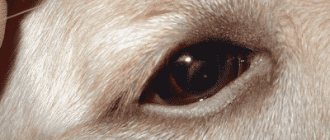Keratitis is an inflammation of the cornea. Recognizing this disease is not so difficult, because normally the cornea is transparent and shiny. But as soon as the inflammatory process “captures” it, the eye immediately becomes cloudy. In most cases (almost 100%), keratitis in cats is acquired.
Causes
Normally, the cornea in cats is transparent and shiny, but if an inflammatory process develops, the eye immediately becomes cloudy. In most cases, keratitis in cats is acquired, and among the most common causes of the development of ophthalmological disease are:
- constant mechanical impact on the cornea;
- thermal, chemical burns of the eyes;
- genetic, breed predisposition;
- chronic viral and bacterial diseases;
- hypo- and vitamin deficiencies;
- autoimmune diseases;
- metabolic disorder;
- endocrine pathologies (diabetes mellitus);
- fungal infections;
- blockage, inflammation of the lacrimal glands;
- allergic manifestations.
Mechanical impact most often provokes bacterial keratitis. A cat can damage its eye with its paw, claw, twigs, or during a fight with its relatives.
Important! Hairless cats are most susceptible to keratitis due to their physical structure and complete lack of eyelashes. Due to the turning in of the eyelids, cats often rub their eyes, which leads to a mechanical defect. Inflammation of the cornea is also noted in cats of the British breed, Siamese, Persians, and brachycephalics.
Keratitis in animals often develops against the background of viral and bacterial infections and diseases. Thus, the herpes virus, which almost every cat is infected with, very often leads to inflammation of the cornea.
Glaucoma
Glaucoma is an eye disease in cats that develops against the background of increased intraocular pressure. The cornea loses transparency during an acute attack of the disease.
Optic nerve atrophy leads to complete blindness of the animal within 2-4 days after the attack. Therefore, the animal needs urgent veterinary care.
Symptoms of an acute attack of glaucoma:
- pain when touching the eye;
- photophobia;
- corneal edema;
- high intraocular pressure.
Treatment for an acute attack of glaucoma involves urgently reducing the pressure inside the eye. Manipulations must be carried out by a veterinary specialist with monitoring of the animal’s condition.
Further treatment consists of the use of drugs that reduce intraocular pressure, diuretics and agents that help stabilize the cat's condition.
Symptoms of keratitis
In order to promptly begin treatment of keratitis, to avoid loss of visual function and other serious complications, owners must know the symptoms of an ophthalmological disease. At the beginning of the development of the inflammatory process, the cat’s eyes begin to water heavily, the sclera turns red, and the eyelids swell. Depending on the stage of the disease, mucous, serous or purulent exudate is released from the eyes. Cloudiness is noted in the cornea of the eyes due to the accumulation of infiltrate.
Main features:
- blepharospasm, blepharitis (squinting, inflammation of the eyelids);
- profuse lacrimation;
- photophobia;
- inadequate reaction of the pupil to light;
- deterioration of visual acuity;
- constantly wet fur under the eyes;
- the presence of a raised gray, white, pink plaque on the surface of the cornea;
- decreased activity.
Typically, the inflammation affects one eye, and keratitis can develop in both eyes of the cat. If treatment is not started, degenerative processes occur in the structures of the cornea, which lead to its delamination and provoke the appearance of scars. In some cases, the cornea grows with blood vessels (vascular keratitis).
Possible manifestations
Depending on its nature, eye keratitis in a cat can occur in acute or chronic form. In the first case, the progression of the disease occurs in parallel with the diseases of the animal’s visual organs: burns, chemical poisoning, and mechanical injuries. In the chronic form, the development of keratitis in a kitten is observed against the background of an infectious disease. As such, large-scale viral and bacterial lesions, manifestations of purulent conjunctivitis, and powerful helminthic infestations are considered. Damage to the ocular cornea can be local or total, depending on the stage of its development.
Your four-legged pet may feel unwell:
- Viral
- Bacterial
- Infectious
- Gribkovogo
- Allergic
- Ulcerative
- Deep purulent character
Diagnosis and treatment
The diagnosis is made on the basis of a number of visual, laboratory, biological, and special ophthalmological (instrumental) studies. The veterinarian conducts a comprehensive examination of the patient. Tear secretion is taken for analysis.
Important! When diagnosing keratitis, a veterinarian will select treatment based on the diagnostic results, the root cause, the severity of the ophthalmological disease, and the depth of damage to the cornea.
Treatment of keratitis in cats is carried out comprehensively. Animals are prescribed medicinal eye drops and antibacterial ointments (chloramphenicol, hydrocortisone), anti-inflammatory, and general restoratives. If inflammation of the cornea is caused by viruses or bacteria, a course of antibiotic therapy, antiviral medications, and sulfonamides will be prescribed. For fungal infections, fungicidal drugs are used in treatment.
For ulcerative keratitis, antiseptic solutions (rivanol, furatsilin, 3% boric acid), medicinal drops and ointments - Dibiomycin, Kanamycin, Erythromycin - help well. Injections into the cornea of the eye may be prescribed; for this form of keratitis, the treatment course takes about three weeks.
To generally strengthen the immune system and normalize the general condition, treatment is supplemented with vitamin and mineral supplements and immunomodulators.
In severe, severely advanced cases of keratitis in cats, surgery will be prescribed.
If treatment for keratitis is started in the early stages, the prognosis is favorable in most cases. The disease responds well to treatment, and the cat’s visual functions are completely restored.
To avoid the development of keratitis, owners of furry cats should pay attention to eye hygiene of their furry pet. Wash your eyes two or three times a week with special antiseptic solutions or instill prophylactic drops. If your pet walks outside, inspect its eyes after each walk.
Protect your pet from stress and hypothermia, strengthen the immune system with vitamin and mineral complexes.
Having noticed the first signs of an ophthalmic disease, take the cat to a veterinary center or clinic. Do not forget that keratitis can cause vision loss and is fraught with other serious complications.
keratitis in cats photo
Keratitis (inflammation of the cornea) is a fairly common inflammatory ophthalmological disease. In most cases, keratitis is an acquired disease. Despite the fact that there are a great many reasons for the development of this ophthalmological pathology and forms of manifestation of keratitis, a common clinical symptom is clouding of the cornea, which can manifest itself to varying degrees.
What is keratitis?
Keratitis is an acquired inflammation of the cornea of the eye, accompanied by pain, redness and clouding of the lens. It occurs due to mechanical damage (bruises, scratches), as well as infections. Complications of keratitis in cats are corneal breakthrough, the appearance of cataracts, cataracts, and glaucoma.
In the early stages, this disease does not appear outwardly, so pet owners may notice disturbances in the visual organs much later. Keratitis most often affects hairless cats, which naturally lack eyelashes and have eyelids that roll inward, irritating the cornea.
How to treat?
The question of how to treat keratitis in cats can be answered after identifying factors such as:
- cause of illness;
- severity of the disease;
- depth of corneal lesion.
Eye keratitis in cats is treated with ointments and eye drops. Sometimes animals are given injections under the conjunctiva. The veterinarian may also prescribe tablets, subcutaneous or intravenous injections.
To treat viral keratitis, antiviral therapy is used - interferon-containing drugs. Complications caused by bacteria are treated with antibiotics and sulfa drugs.
For allergic keratitis, local and general antiallergic drugs are prescribed. If there is a threat of corneal perforation, corneal plastic surgery is performed to varying extents.
How to avoid developing keratitis in cats
Prevention of a disease that can cause complete blindness consists of high-quality animal care, regular examination of the pet’s eyes, and proper nutrition. It is important to periodically carry out deworming and timely vaccinations. It is recommended to exclude the animal from being outside for long periods of time during the cold season and to minimize its contact with stray cats.
Long-haired pets require special attention. These cats need frequent brushing and periodic trimming of eye hair.
If keratitis develops in a cat, its owner should avoid self-medication, uncontrolled use of pharmaceutical drugs or folk remedies. It will be possible to preserve your pet’s vision and completely rid it of unpleasant pathology only under the supervision of a veterinarian.
Our materials will be useful for you and other users. Share the article on social networks! Click!
Description of ophthalmological disease: keratitis in cats
All representatives of the cat family are susceptible to the disease; the disease can manifest itself at any age, but most often this pathology is diagnosed in animals after five years.
Etiology of keratitis. Causes of pathology in cats
Corneal lesions can occur due to constant mechanical impact, as a result of accidentally received superficial, deep eye injuries, wounds of various etiologies, external pathological effects on the cornea of various unfavorable factors, concomitant secondary viral, fungal or bacterial infections in the body.
The development of inflammatory processes in the body can also be caused by allergic reactions, neurogenic disorders, vitamin deficiencies, autoimmune infections, disturbances in the lacrimal glands, endocrine pathologies, metabolic disorders in animals, and genetic (breed) predisposition.
In representatives of the cat family, the causes of the infectious form of keratitis are feline herpes virus and adenoviruses . In cats, representatives of Siamese, Persian, British breeds, American smooth-haired breeds, and Sphynxes are most often predisposed to keratitis. In sphinxes, the development of keratitis is due to the absence of cilia and the presence of a large number of folds that affect and put pressure on the eyelids.
Classification of keratitis, clinical symptoms in cats
Keratitis, depending on the etiology, can occur in an acute form, which develops within several hours, and in a chronic form. They can be total and local, in which damage to individual, small areas of the cornea is diagnosed. With local damage, small cloudy spots of small diameter are noted. With total keratitis, the inflammatory process completely affects the entire surface area of the cornea, which leads to decreased visual function, loss of visual acuity and blindness.
The acute form, in which clouding of the cornea occurs within several hours, most often develops against the background of concomitant eye diseases - chemical poisoning, eye injuries, contact with the eyes of certain medications, constant mechanical stress, burns, hepatitis, enteritis. When the outer layer of the cornea is damaged, superficial keratitis develops, which, if not treated in a timely manner, can develop into the chronic stage of ophthalmological pathology.
Chronic keratitis (vascular, pigmentous) develops over several days, weeks or months. Moreover, in some cases, the chronic form of keratitis, which leads to destructive and degenerative processes in the structure of the cornea of varying intensity and degree, can develop for years. The chronic form of the pathology can develop against the background of long-term purulent conjunctivitis, dry eye syndrome, chronic bacterial or viral infections. Some forms of keratitis can be caused by severe helminthic infestations.
If animals are not given correct and timely treatment, the prognosis is unfavorable and can lead to atrophy of the optic nerve, loss of vision, impaired sensitivity, lack of specularity and shine in the eyes. As the disease progresses, inflammatory processes can spread to the iris, sclera, ciliary body, cause inflammation of the ciliary follicles, corneal perforation (corneal rupture), secondary glaucoma, and a complicated form of cataract.
Depending on the etiology, causes of development, degree of damage, keratitis can be: infectious, viral, bacterial, fungal, allergic, keratitis of immune origin, deep purulent keratitis, superficial vascular keratitis, ulcerative, parenchymal form of keratitis.
Symptoms of keratitis in cats
The clinical picture and symptoms of keratitis depend on their shape, the intensity of pathological inflammatory processes in various balls and structures of the cornea.
Regardless of the form of this ophthalmological pathology, keratitis manifests itself as a sharp or gradual clouding, thickening, change in color of the cornea, soreness, redness, swelling of the conjunctiva, protrusion of the third eyelid, and photophobia are noted. The animal shows anxiety, constantly rubs the affected eye, activity decreases, and due to severe painful spasms, animals may refuse to feed. The cornea turns pale, acquires a yellowish, bluish, gray-blue or yellowish tint.
With the superficial vascular form of keratitis, disturbances in the blood supply to the eyes, ingrowth of blood vessels into the surface layers of the cornea, and clouding of the connective tissue vessels are noted. with deep purulent lesions, damage to the corneal tissue occurs due to the penetration of pathogenic flora into the corneal stroma. In animals, corneal edema, blepharospasm, deterioration in general condition, depression, decreased activity, drowsiness, and the formation of purulent exudate in the corners of the eyes are noted.
Forms of violation
Feline keratitis can take two forms:
- Spicy.
- Chronic.
The acute form of the disease develops rapidly. With this type of pathology, the patient's condition worsens within a few hours. It is typical for acute keratitis to manifest itself against the background of existing ophthalmological problems, intoxication, injuries to the visual organ, and the presence of foreign objects in the eyeballs. In case of untimely treatment, acute keratitis often becomes chronic.
Chronic keratitis, also called vascular or pigmentary, is characterized by a long development - from several weeks to 2-3 months or a whole year. This form of disorder is provoked by long-term purulent conjunctivitis, dry eye syndrome, chronic bacterial or viral infections. Sometimes the cause of the disease in cats is helminthic infestations.
Keratitis in animals can also be local and total. In the first case, individual areas of the cornea are affected, and small cloudy spots are found in the eye. If there is a total form of the disease, the entire surface of the cornea is covered by the inflammatory process. The consequences of this are a severe decrease in visual acuity and even blindness.
How does a corneal ulcer occur in a cat and how dangerous is it?
The cornea becomes pale and acquires a yellowish or white-yellow tint.
Diagnosis and treatment of keratitis in cats
When the first clinical symptoms appear, it is necessary to begin treatment of acute keratitis as soon as possible in order to prevent the pathology from becoming chronic, as well as to avoid the formation of scars and the appearance of cataracts on the cornea. In the chronic stage, treatment directly depends on the location, extent of damage and duration of damage to the cornea.
The diagnosis is made based on the clinical picture and severe symptoms, as well as on the results of eye biomicroscopy, which makes it possible to determine the location and depth of the lesion. To determine sensitivity, visual function, and identify defects in the epithelial layer of the cornea, the fluorescein strip method is used. In case of purulent form of keratitis, additional bacteriological tests are performed.
Treatment of keratitis involves complex techniques that depend on the form and type of keratitis. The prognosis of the disease depends on the causes, location and duration of the disease. First of all, treatment is aimed at eliminating the root cause that led to the development of pathology.
In case of viral, bacterial, fungal forms of pathology, animals are prescribed appropriate antibacterial, antifungal medications, broad-spectrum antibiotics (local or general effects), and immunomodulatory drugs. For ulcerative and purulent lesions, antiseptic drugs and eye drops are poured into the conjunctival sac.
For the superficial form of keratitis, good results are achieved by using chloramphenicol eye drops in combination with subconjunctival injections of prednisone and hydrocortisone.
For purulent forms of keratitis, antibacterial eye drops and a course of antibiotics are prescribed.
In case of ulcerations, the presence of neoplasms, perforated ulcers against the background of general symptomatic therapy, microsurgical intervention is performed and additional therapeutic procedures are prescribed.
see additional section - eye diseases:
Keratitis is an inflammatory eye disease that results in damage to the cornea. This disease is quite common among our smaller brothers, its main danger is loss of vision. Therefore, it is important to know the symptoms and causes of this “sore”, because it is much easier to treat the disease in the initial stages of manifestations.
Symptoms
Most often, the symptoms of keratitis in cats are severe. This allows pet owners to immediately recognize the disease and promptly seek veterinary help.
Haemorrhoids
Food allergies
Chronic renal failure
The main manifestations of the pathology are described below:
- Cloudiness of the cornea. In a sick cat, this structure loses its healthy transparency and becomes dull and rough. The disorder affects one eyeball or both.
- Severe redness. This phenomenon is caused by an inflammatory process in the eye.
- Accumulation of infiltrate inside the cornea. Such an anomaly provokes swelling of the upper layer of the visual organ.
- The flow of pathological exudate, as a result of which the fur on the face becomes constantly wet. In addition, pus often accumulates in the corners of the eyes.
- Severe photophobia. Healthy cats bask in the sun with pleasure, while sick pets strive in every possible way to hide from any sources of light (both natural and artificial).
- Loss of normal appetite, lethargy, apathy. Similar symptoms are typical of keratitis and other diseases affecting animals.
The disease is also characterized by symptoms such as frequent squinting, excessive lacrimation, and inflammation of the eyelids.
In some cases, the cornea grows blood vessels. Sometimes a dark spot forms in the center of the cornea. There may be a lack of eye coordination and a change in the natural color of the iris.
When the pathology becomes chronic, the volume of discharge decreases, but the conjunctiva becomes thickened. Some cats experience eversion or inversion of the eyelids.
If the disease actively progresses and is not treated, tissue scarring occurs and a cataract forms. In particularly difficult cases, therapy becomes ineffective, and the pet inevitably loses vision.
Therapy methods
Treatment at home is carried out as prescribed by a veterinarian.
For infectious pathologies, antibiotics are used, and antibacterial agents can be used.
Identified corneal ulcers and glaucoma require surgical intervention. Often, for glaucoma, complete removal of the eye is performed.
Excision of corneal ulcers is a less painful procedure. During this procedure, only the affected tissue is removed. After the procedure, scars remain that prevent full restoration of vision.
Therapy is carried out using non-steroidal anti-inflammatory drugs. The drugs have an impressive list of contraindications and, with prolonged treatment, can negatively affect the general condition of the animal .
For any pathologies, it is recommended for the cat to drip antiseptic drugs and apply medicinal ointments. At the same time, the affected organ is moisturized.
With timely treatment, it is possible to prevent the penetration of pathogenic microorganisms.
The cat needs to create comfortable conditions. He needs rest and diet.
Sometimes complex therapy is used:
- use of Gamavit and Tetracycline ointment;
- washing the organ with Metrogyl solution;
- use of drugs containing Actovegin;
- prescription of antiviral drugs.
Traditional methods of treatment
Traditional medicine should be used carefully. It is advisable to consult a veterinarian before starting therapy.
The following remedies will help alleviate your pet's condition:
- Tea. 1 tbsp is poured into a glass. dry tea leaves, pour boiling water. Use after completely cooled.
- Elder. To prepare the medicine, 1 tsp. elderberries are poured with boiling water (0.5 cups). Let the liquid infuse for about an hour and filter.
- Celandine. Five leaves pour 2 tbsp. boiling water The liquid is infused for half an hour, then filtered.
- Calendula: 2 tbsp. raw materials are poured with a glass of boiling water, left for a quarter of an hour, filtered.
- Aloe. Three leaves are crushed in a blender, the juice is filtered using gauze.
Medicines are used as follows:
- moisten a cotton pad in the liquid and move it from the outer corner to the inner one;
- change the cotton pad after each wipe;
- both eyelids are treated.
Treatment of keratitis at home
If keratitis is detected in a cat, you should definitely see a veterinarian; if the treatment process is delayed, the pet may lose its vision.
First aid when detecting keratitis:
- Remove the cause of keratitis;
- Rinse the eye with an antiseptic solution, brewed tea or herbal decoction.
- Antiseptic solution: From furatsilin tablets - 2 tablets per glass of warm boiled water, leave for 10 minutes, strain through gauze before use.
- Potassium permanganate (manganese) 1 grain per 1 liter of water, the solution should be slightly pink, otherwise there will be a burn to the eye tissue.
- The drops used are “Iris”, “Floxal”, “Levomycytin drops”, “Maxidin”, “Ciprofloxacin”, “Sofradex”, “Bars”.
Recommended reading:
How to cure toxoplasmosis in cats - prevention and symptoms
pet treatment
Folk remedies:
- Drops of honey, propolis.
- Parsley and dill juice are not used in pure form, but in a 1:2 ratio with boiled water. If you make a lotion from juice, you should not dilute it.
- Infusion of bay leaf.
- Potato juice.
- Decoction of rose hips.
Causes of keratitis in cats
Inflammation of the cornea can be caused by many factors. In most cases, the disease is caused by mechanical damage, bacterial, viral or fungal infection, as well as some systemic diseases.
- Bacterial - occurs when the eye is injured and bacteria enter its structure. It occurs acutely, with the development of severe purulent complications.
- Viral - the most common viruses are adenovirus and herpevirus.
- Fungal - like bacterial ones, arise from mechanical damage. In this case, peculiar “crumbs” appear in the pet’s eye, with a complication in the form of perforation of the cornea and damage to the deeper layers.
- Neurogenic – possible when nerve tissue is damaged. The appearance of an ulcer in the center of the eyeball is typical and does not cause pain or anxiety in the pet. If a secondary infection does not occur, the disease resolves itself.
- Allergological - due to improper use of medications, as well as from certain allergic agents in the period after vaccination.
Keratitis in dogs and cats
keratitis in a cat
Keratitis is an inflammation of the cornea of the eye, accompanied by clouding and decreased vision, including blindness.
Inflammation of the cornea is usually acquired in nature and can be superficial, deep and ulcerative.
There is local keratitis, in which a small area of the cornea is affected. In this case, the cloudiness looks like one or several spots. Total keratitis affects the entire area of the cornea, and the animal’s vision either decreases significantly or disappears completely.
Keratitis can occur suddenly - with acute eye infections, poisoning, burns, hepatitis, enteritis, etc. Chronic keratitis develops over several weeks or months. They are usually a complication of chronic purulent conjunctivitis, dry eye syndrome, and viral infections.
The causes of keratitis and their forms are diverse:
- Mechanical keratitis occurs when a foreign body enters. This also includes eye bruises, scratches received during a fight or scratching oneself.
- Inversion of the eyelid or growth of eyelashes towards the cornea is a congenital pathology, although inversion of the eyelids can also be observed in adult animals.
- Bacterial keratitis occurs due to microtrauma of the cornea, and the infection comes from the traumatic object itself.
- Ulcerative keratitis (corneal ulcer) is an inflammation of the cornea of the eye, accompanied by necrosis (death) with the formation of a defect in its tissue. There are purulent, creeping and perforated corneal ulcers. According to the nature of occurrence, they distinguish between infectious (due to bacterial, viral, parasitic infection) and non-infectious (usually an ulcer of immune origin in dry eye syndrome and absolute glaucoma, neurogenic and traumatic factors).
- Corneal sequestration (corneal necrosis) is a pathology of the cornea of the eye, which mainly occurs in cats of brachycephalic breeds and manifests itself in the form of a local change in the color of the cornea from translucent, brown to black. The course of the disease is chronic, which can last from three weeks to a year or more.
- Herpetic keratitis most often occurs in German and East European Shepherd dogs and is caused by the pathological effects of viruses.
- Fungal keratitis (keratomycosis) occurs as a result of damage to the cornea by any foreign object, as a result of which a persistent crumb-like clouding of the cornea, white in color with a light yellow edge, is visualized in the area of injury. At the same time, the deep layers of the cornea are also involved in the inflammatory process, which subsequently slowly collapse and lead to perforation (perforation) of the cornea.
- Allergic keratitis occurs mainly acutely after consuming medications, foods intolerable to the body, exposure to pollen and dust on the eyes during the post-vaccination period, etc.
- Neurogenic keratitis occurs as a result of damage to trophic nervous tissue (atlantoaxial instability). A flat ulcer forms in the central part of the cornea. The process is usually slow and lengthy. When a secondary infection occurs, purulent inflammation of the cornea occurs, which can result in perforation of the cornea or its complete destruction.
- Keratitis associated with metabolic disorders and systemic pathologies, such as hypovitaminosis, chronic renal failure, diabetes mellitus. The state of general and local immunity is important in the development of the disease; it also largely determines the nature of the course of keratitis and the severity of the pathological process.
There is a certain breed predisposition to keratitis. Most dogs suffering from keratitis have a brachycephalic skull structure (boxers, French bulldogs, pugs, Pekingese, etc.). Keratitis occurs in dachshunds and shepherds. In cats, representatives of the British and Persian breeds are most predisposed to keratitis.
Symptoms
The main clinical manifestations of keratitis include:
- Tearing
- Mucous, purulent, fibrinous discharge
- Spasm of the eyelids
- Photophobia
- Foreign object sensation (the animal constantly tries to scratch the affected eye)
- Redness of the conjunctiva
- Violation of the transparency of the cornea of the eye. Gray, yellowish-gray, gray-blue opacities appear in the cornea.
The long course of the disease is accompanied by a violation of the integrity of the cornea, irregularities and depressions appear. In severe cases, there is a perforation (rupture) of the cornea of the eye with prolapse of the iris. Secondary glaucoma, iritis and iridocyclochoriditis may form.
Diagnostics
Keratitis in a dog
Inspection in side lighting using an electric flashlight.
To determine the sensitivity of the cornea, a cotton tourniquet is used, which is passed over its surface. This method is also suitable for determining the integrity of the trigeminal and motor nerves, which are components of the blink reflex.
Schirmer's tear test - to assess the production of tear fluid. The test should be performed before instilling local anesthetics, fluorescein, or rinsing the eyes. It may indicate insufficient tear secretion and possible dry eye syndrome, which often precedes keratitis.
The fluorescein strip method is used to identify defects in the corneal epithelium. This method uses an ophthalmoscope with a cobalt blue filter or a Wood's lamp to identify areas of staining (corneal defects are stained).
Differential diagnosis: dystrophic, inflammatory and cicatricial processes in the cornea.
The presence of lacrimation, photophobia, and eyelid spasms indicates an inflammatory process. The absence of signs of eye irritation indicates that the inflammatory process has already ended and the loss of transparency is caused by the development of scar tissue. The dystrophic process with keratitis occurs with a significant change in its surface layers; as a rule, during this process there is no phenomenon of irritation, the tactile sensitivity of the cornea disappears completely.
Treatment
Treatment depends on the cause of keratitis, the depth of corneal damage, and the severity of the disease.
For keratitis, medications are used in the form of eye drops, ointments, some drugs are administered as injections under the conjunctiva, into the postorbital space. Tablet forms, intramuscular, subcutaneous and intravenous injections are recommended.
Be sure to start by washing the cornea with antiseptic solutions suitable for the eyes.
Antiviral therapy is used in the treatment of viral keratitis. For herpetic keratitis - drops, ointments, tablets containing acyclovir.
When treating bacterial keratitis, antibiotics and broad-spectrum sulfonamide drugs are prescribed, and when receiving the results of a bacteriological study, taking into account the sensitivity of the pathogen to the antibiotic.
The treatment of allergic keratitis requires the use of antiallergic drugs, both local and general.
If there is a threat of corneal perforation, a pronounced decrease in vision as a result of cicatricial changes, a cosmetic defect, etc., corneal plastic surgery is performed in varying volumes.
Prevention of keratitis consists of timely and adequate treatment of blepharitis, conjunctivitis and dacryocystitis, general diseases of the body that contribute to corneal disease, and the prevention of eye injuries.
How it manifests itself
The main symptoms of keratitis in cats are redness of the eyes. Depending on the cause of the disease, lacrimation can be purulent, serous or mucous in nature. Swelling is possible, the eye loses its shine and becomes cloudy. The cat will constantly scratch the affected area.
If not treated in a timely manner, iris loss, development of secondary glaucoma and iridocyclitis (inflammation of the iris) are possible.
The disease not only brings discomfort to your pet, but also has many complications that can lead to more serious structural damage and loss of vision. The cornea may lose transparency, and during healing, cataracts and scars may form. This is especially true during the transition of an acute process to a chronic one.
With prolonged exposure to damaging agents, corneal ulcers or necrosis may develop.
Symptoms of inflammation of the cornea of the eye
As mentioned above, signs of keratitis do not appear immediately. A specialist in this field - a veterinarian - can recognize the true “face” of the disease. At the first symptoms of keratitis, the animal begins to squint and avoids light. In the future, various discharges of a purulent, serous nature may be released from the eyes, and the cornea becomes cloudy. Symptoms of keratitis in cats can appear in both eyes at once. Depending on the type of the disease, accompanying problems arise:
- The cornea becomes dull and has an unusual shine due to superficial keratitis.
- Cloudiness of the center of the eye occurs with superficial erosive keratitis.
- A cornea with a dark spot in the center can be seen with sequestered keratitis.
Forms of the disease can manifest themselves in blepharitis, blepharospasm and epiphora.
Establishing diagnosis
To determine the cause of the pathology, an examination of the eyeball is performed. It is possible to establish the true cause of the pathology through a comprehensive examination, which includes:
- taking anamnesis;
- use of fluorescein;
- tonometry;
- ophthalmoscopy;
- serological, biochemical and general blood tests;
- cytology or microscopy;
- smear culture;
- examination of intraocular fluid samples;
- Ultrasound of the eyeball;
- gonioscopy.
Anamnesis collection includes information about the animal’s contacts, menu composition, the presence of concurrent diseases and methods of their treatment. To determine the presence of ulcers, the cornea is stained with a fluorescent substance.
Main symptoms
When the cat gets sick, it shows nervousness and increased excitability. However, based on the cause of its appearance, parallel signs characteristic of a specific pathology are observed. There are three degrees of damage.
- Peripheral degree - present as a border, on the edges of the apple.
- The central lesion is the very center of the organ of vision.
- Total degree - the eye is completely closed.
At the same time, the cat’s behavior changes. Due to decreased vision, the pet walks unsteadily and does not see obstacles in the form of furniture or other objects. Nervousness and increased excitability appear. Strabismus can often be observed. In the presence of inflammation, there is pain, discharge, and swelling of the mucous membrane.
Diagnostics
The owner can notice the very first signs of the disease. Particular attention should be paid to lacrimation - this is the first diagnostic sign that will help you pay attention to your pet and visit a veterinarian in time. It is also worth paying attention to the animal’s inability to fully raise the eyelid; visually the eyes will look asymmetrical.
In a veterinary clinic, to determine the nature of inflammation, a tear test is used, which will help determine the sufficiency of tear fluid production and, as a result, exclude or confirm dry eye syndrome.
To detect the presence of defects in the cornea, a special fluorescent liquid is used. When using lamps, damage will be highlighted.
conclusions
Constant observation and control is the key to successful treatment. If you notice the slightest sign of deterioration - increasing areas of redness, pain or a sharp increase in discharge - immediately contact a veterinarian.
Observation by a veterinarian and monitoring the cat’s condition is the key to successful treatment.
Treatment
Under no circumstances should you start treatment without consulting a specialist. You may make the disease worse and cause serious complications. Therapy is prescribed based on an examination by an ophthalmologist, who will determine the extent of the damage.
Bacterial keratitis must be treated with antibiotics. Sulfonamide drugs are mainly used in the form of drops. In acute cases, the doctor must inject hydrocortisone into the area of the conjunctival sac. Novocaine can also be administered to relieve pain.
For home use, it is necessary to use antiseptic rinsing solutions - 1% solution of furatsilin or boric acid.
If keratitis is viral, antiviral drops and ointments are used, for example, acyclovir or Zovirax.
The pet should be supplemented with vitamins by providing a full menu and a separate addition of tableted vitamins.
How to protect your pet
Everyone knows that the main thing in maintaining health is prevention. And our little brothers are no exception. Keratitis can be prevented if you follow several rules:
- Get vaccinated in a timely manner. This will help avoid contracting viral infections.
- Try to examine your pet, especially if it has long hair. It can easily get into the eyes, becoming a source of disease.
- If you find your cat simply has red eyes (conjunctivitis), it is better to immediately contact a veterinary clinic. Without proper treatment, inflammation can spread to other structures of the eye.
Preventive measures
In order for the cat to be healthy and not subject to such an ailment as keratitis, you can resort to the following measures:
- in the room where the cat is located, constantly carry out wet cleaning, wash surfaces and floors, and cat accessories;
- after a walk outside, inspect your pet’s eyes for the presence of foreign objects;
- if the individual has long hair, comb it well or trim it near the eyes so that it does not get into the eye cavity and injure it;
- ensure that the animal is not exposed to the cold for long;
- if the animal's eye is watery, carefully monitor it, rinse it with boric acid and ask a veterinarian for advice;
- carefully monitor your diet. It is important that the diet is complete, with sufficient vitamins and minerals;
- carry out routine deworming;
- active animals should be inspected more often for mechanical damage;
- Get vaccinated against infections starting at a young age;
- do not self-medicate, since therapy if the diagnosis is incorrect can threaten the individual with complete blindness. If the disease continues to develop after prevention, you need to show the animal to a doctor.
If you follow these recommendations and contact the clinic in time when signs of disease are noticed, the cats will not have major health problems, which will save not only money, but also the nerves of all family members.











